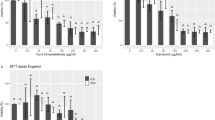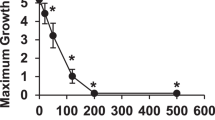Abstract
Cytological studies in the light microscope showed that thioacetamide (TAA) depressed the mitotic index in cultures of skin fibroblasts at the lowest concentrations used (100 μg/ml). At high concentration (1 mg/ml), TAA tended to cause aberration in nuclear morphology. Ethylenethiourea (ETU) had no effect on either mitotic index or nuclear morphology at 1 mg/ml. Fibroblast cultures treated with 1 mg/ml TAA and cultures grown in the presence of 2 mg/ml ETU were studied by electron microscopy. In some TAA-treated cells there was unfolding of the nuclear membrane and enlargement and granulation of the nucleolus, but these effects were not correlated. In all cells, TAA caused severe and characteristic damage to the majority of mitochondria, whether or not there were nuclear aberrations. The organelle showed extensive swelling of the cristae of the inner membrane and an increase in matrix density. Ultrastructure of other cell components appeared to be unaffected by this treatment. In ETU-treated cells some less severe swelling of inner mitochondrial membranes was seen and only in a minority of cells, whilst all other cell structures appeared normal. Similar membrane swelling and increase in matrix density was seen in isolated rat liver mitochondria after incubation with TAA, indicating a direct antimitochondrial effect of the carcinogen.
When yeast cells were treated with TAA and ETU, primary antimitochondrial activity of these compounds was apparent from (1) inhibition of growth in non-fermentable medium, (2) selective blockage of mitochondrial protein synthesis and (3) induction of mitochondrial mutations. TAA was much more effective than ETU in all these respects.
This is a preview of subscription content, access via your institution
Access options
Subscribe to this journal
Receive 24 print issues and online access
$259.00 per year
only $10.79 per issue
Buy this article
- Purchase on Springer Link
- Instant access to full article PDF
Prices may be subject to local taxes which are calculated during checkout
Similar content being viewed by others
Rights and permissions
About this article
Cite this article
Diala, E., Mittwoch, U. & Wilkie, D. Antimitochondrial effects of thioacetamide and ethylenethiourea in human and yeast cell cultures. Br J Cancer 42, 112–120 (1980). https://doi.org/10.1038/bjc.1980.209
Issue Date:
DOI: https://doi.org/10.1038/bjc.1980.209
This article is cited by
-
Mitochondrial abnormalities in hepatocytes adjacent to fibrolamellar hepatocellular carcinoma
Journal of Tongji Medical University (1986)



